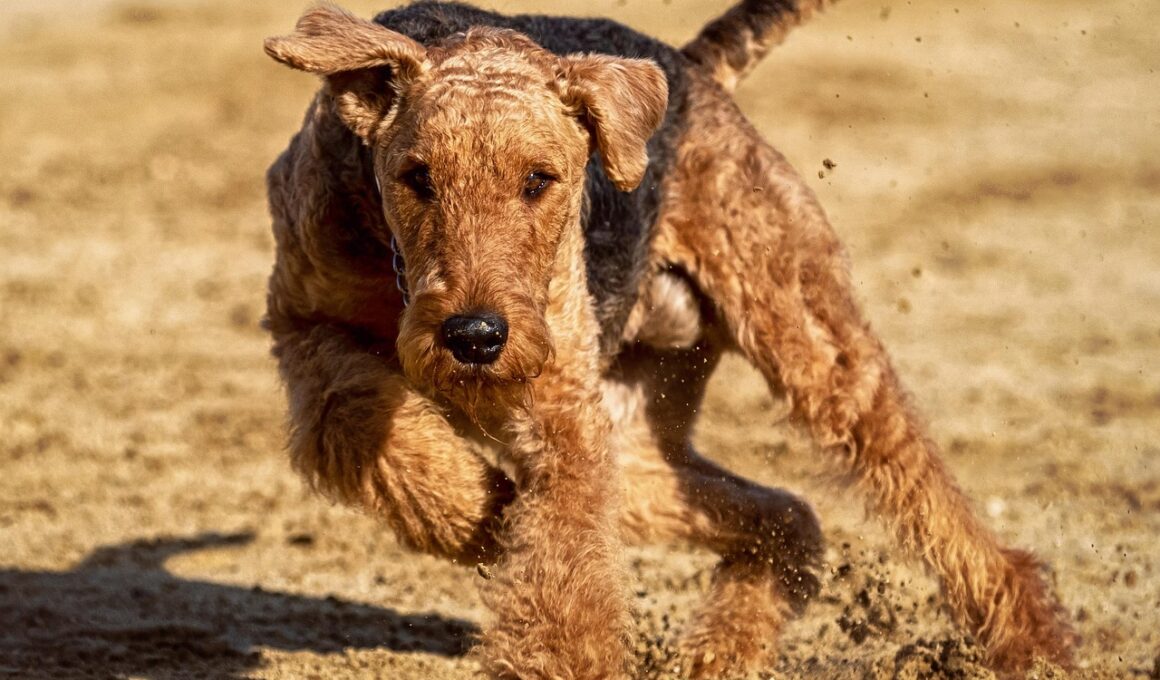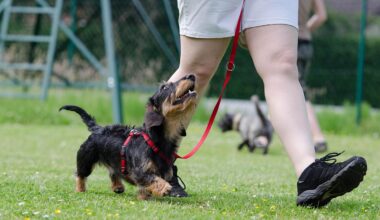How to Use Shutter Speed Effectively in Dog Action Photography
Capturing stunning action shots of dogs is a rewarding challenge for photographers. Understanding how to manipulate shutter speed is crucial to freeze the moment, ensuring clarity and sharpness. Using a faster shutter speed, typically around 1/500 second or faster, allows you to capture quick movements without blur. In various conditions, particularly outdoor settings with good lighting, these settings are ideal. Additionally, consider the dog’s breed and activity level while shooting; fast-moving breeds require faster shutter speeds. Experimenting with your camera settings can help you find the perfect balance. Try different speeds to discover which yields the best results in different scenarios. However, be attentive to your surroundings. Shooting in bursts can significantly increase your chances of getting the perfect shot. Typically, shooting in burst mode will take several frames per second, making it easier to catch action shots. Regardless of the fastest speeds, always ensure that your focus is sharp. It may require practice, yet the results will speak for themselves when you achieve that perfect shot of your furry friend in action.
Once you’ve mastered basic principles of shutter speed, lighting becomes an additional factor. Good lighting allows for higher shutter speeds, reducing motion blur significantly. Shooting in natural daylight benefits your shots tremendously. If the environment is darker, consider adjusting your ISO settings; however, using a higher ISO can introduce noise. This can detract from the quality of your image, particularly in low-light conditions. Moreover, employing a lens with a wider aperture can yield brighter images while enabling faster shutter speeds. For instance, using prime lenses with lower f-stop values can help capture fast action better. Another aspect to consider is the angle from which you capture your dog. Getting low to the ground often allows for dramatic viewpoints. Shots taken from the dog’s perspective tend to convey excitement and vitality. Understanding how to track and anticipate their movements will result in compelling action shots. Besides shutter speed, incorporating techniques like panning adds dynamism. Panning entails moving your camera in sync with the dog’s motion, keeping them in focus while blurring the background, bringing attention to the action.
Creating Dynamic Shots with Panning
When mastering dog action photography, panning techniques can create a significant impact in conveying excitement and energy. To begin, select a fast subject and maintain its pace while adjusting your camera settings accordingly. Comprehending the fundamentals of panning involves setting a slower shutter speed, typically around 1/125 to 1/250 second, while following the dog’s movement. This technique blurs the background while keeping the subject sharp, contributing to an effect of speed and motion. Begin with a tripod or stabilize your camera for better shots; follow-through is essential. It allows you to track the subject while properly composing the scene. As your dog moves, swivel your torso to remain aligned with them. Practice this technique diligently, as success lies in timing and smoothness. Capture multiple frames while executing the panning motion; many images may need a little refinement later. Afterward, it’s wise to examine your images to understand what works and what doesn’t. Post-processing plays a crucial role in enhancing the final product. Adjust exposure, contrast, and colors to achieve the desired outcome before showcasing your stunning images of action.
In addition to panning, monofocusing enables unique shot opportunities in dog action photography. By utilizing continuous autofocus mode, photographers maintain focus on a moving subject, making it easier to prevent motion blur in rapid situations. When aiming for perfection, select a specific focus point prior to shooting. Frame your shots while keeping the focus on the dog. This setting allows you to adjust easily and track their movements. Establishing a relationship with the dog narrates their story and helps in anticipating their actions. Familiarize yourself with their habits and play styles to capture engaging moments. Shooters will also find it beneficial to invest in quality lenses, ensuring they perform well in action sequences. Lenses with fast autofocus systems and appropriate focal lengths enhance the shooting experience significantly. Additionally, using zoom lenses allows you to adjust without disturbing your subject. This versatility enables excellent framing, regardless of the dog’s position. As with all photography, practice is essential. The more time spent shooting in various settings results in an elevated skill set about both shutter speed and overall technique, leading to quality images.
Understanding Movement and Anticipation
To achieve captivating action shots, understanding dog behavior is critical. Observing the dog’s movements can greatly assist in predicting when the best shots will occur. When photographing dogs, particularly during play, identifying their signals leads to a heightened chance of successful captures. For instance, before a dog leaps, they will often crouch, raising their hindquarters and preparing to spring forward. Recognizing this behavior empowers the photographer to adjust settings beforehand. Being ready will allow for those stunning split-second images where their energy shines. Anticipation paves the way for extraordinary photography. Further, consider utilizing a camera with burst mode to enhance your chances of successful captures. Taking several shots in quick succession ensures that you won’t miss essential moments and allows you to choose the best frame later. Understanding the composition of your shots also contributes to their effectiveness. Pay attention to elements like background and framing as they can enhance or detract from your images. An exciting background can set the mood, while a cluttered one can draw attention away from the dog. Thus, be selective when choosing locations for your action photography shoots.
In dog photography, capturing emotions is as vital as snapping quick movements. Dogs express an array of emotions, and freezing these moments brings life to your images. To achieve this, focus not only on their movement but also on their expressions. Finding moments when the dog showcases excitement or joy will yield stunning results. Timing and understanding your subject’s character have tremendous importance. Engage with your dog, employing toys or treats to induce various expressions, and allow that bond to shine through in your photos. Connection with your subject is crucial, and this needs to be established before shooting begins. To further capture expressive shots, consider incorporating close-ups which reveal intricate facial details. This can portray emotions effectively, enhancing the narrative of the photograph. Additionally, shallow depth of field can efficiently isolate the subject from the background, emphasizing the details that convey the dog’s personality. Always have patience; securing the perfect emotional moment might take time. As with all artistic endeavors, patience and practice result in rewarding experiences that enhance your photography skills, allowing you to develop your distinctive style through dog action photography.
Final Thoughts
Mastering shutter speed in action photography requires practice, focus, and understanding. By applying these techniques, you can unlock the door to captivating images that capture dogs in motion. It’s important to experiment continuously; shooting with varying shutter speeds and learning how each affects your compositions will aid growth in skills and technique. Explore diverse environments and challenge yourself to capture action under various lighting conditions. Every shot taken adds value to your improvement, allowing you to pinpoint your strengths and weaknesses. Engaging with your subject enhances the experience; understanding their personality greatly improves the nuances captured in photographs. Don’t shy away from failing, as it is a fundamental part of growth in any art form. Over time, as you refine your craft with consistent practice and dedication, you’ll find your unique style emerging. Embrace every opportunity – whether it be spontaneous outbursts of energy or quiet moments of companionship. Ultimately, dog photography is both an exhilarating and fulfilling path to explore, and your evolving skills will lead to stunning outcomes. Cherish each moment spent alongside your furry friend, and let your creativity shine through your photography journey.


